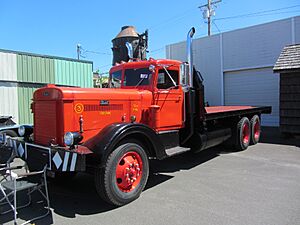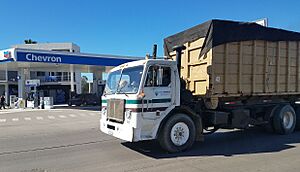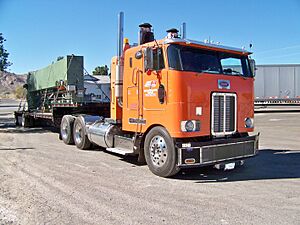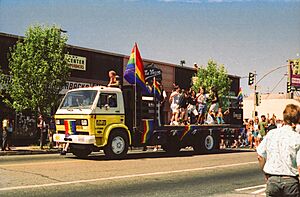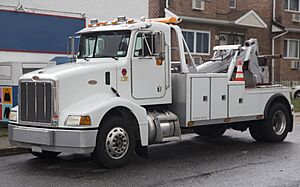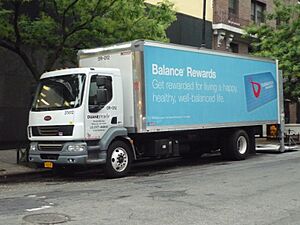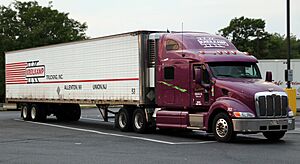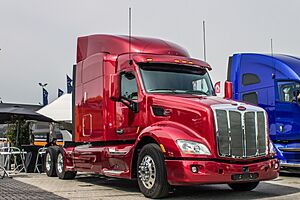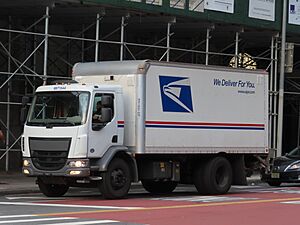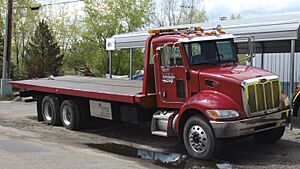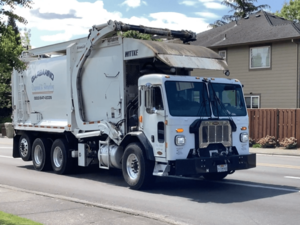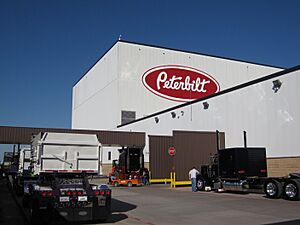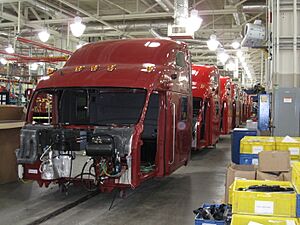Peterbilt facts for kids
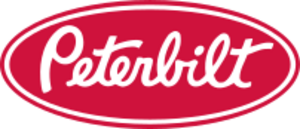 |
|
| Division | |
| Industry | Manufacturing |
| Predecessor | Fageol |
| Founded | 1939 |
| Founder | T.A. Peterman |
| Headquarters | Denton, Texas, U.S. |
|
Key people
|
Allan Ash (president and CEO) Jake Montero (general manager). |
| Products | See listing |
| Parent | PACCAR |
Peterbilt Motors Company is an American company that makes big trucks. They build both heavy-duty trucks (like the huge ones you see on highways) and medium-duty trucks (which are a bit smaller). The company was started in 1939 by a man named T.A. Peterman. Since 1958, Peterbilt has been part of a larger company called PACCAR.
Peterbilt trucks are easy to spot! They have a special red oval badge that has been used since 1953. Many of their trucks also have a cool "bird" shaped ornament on the front hood, which started in 1965.
The main office for Peterbilt is in Denton, Texas, in the United States. They also build trucks in Sainte-Thérèse, Quebec, Canada, and Mexicali, Mexico.
Contents
- How Peterbilt Trucks Began
- Early Years: 1939-1940s
- Growth and Changes: 1950s
- New Factories and Designs: 1960s
- Innovation and Expansion: 1970s
- Modern Era: 1980s
- New Millennium: 1990s and 2000s
- Modern Trucks and Electric Future: 2010s and 2020s
- Peterbilt Truck Models
- Where Peterbilt Trucks Are Made
- See also
How Peterbilt Trucks Began
From Forests to Freeways
Peterbilt started because of the need to move logs in the Pacific Northwest. In the early 1900s, moving logs was slow. People used steam tractors, horses, trains, and even water. T.A. Peterman was a lumberman who wanted to find a faster way to get logs to sawmills to make plywood.
In 1934, Mr. Peterman bought a lot of forest land. Instead of building railroads, he built roads and bought a fleet of trucks. He used old military trucks from the U.S. Army. These trucks were fixed up and changed to be stronger for logging. They even got new features like electric starters instead of hand cranks! Safety was also improved with air brakes.
In 1938, Mr. Peterman found out that another truck company, Fageol Truck and Motor Company, was for sale. He saw a chance to start making new vehicles. So, in 1939, he bought Fageol for $50,000. This included the factory in Oakland, California, and all its tools and parts.
Early Years: 1939-1940s
In 1939, the Fageol factory in Oakland became Peterbilt Motors Company. To design their trucks, Peterbilt engineers asked truck owners and drivers for their ideas. At first, they planned to make trucks for logging. But soon, they decided to focus on trucks for moving goods on highways.
In April 1939, Peterbilt sold its first trucks. These were the Model 260 and Model 334. Both could have gasoline or diesel engines. Their cabs were made of steel and had plywood from Mr. Peterman's own lumber mills inside. For the next 40 years, Peterbilt used a simple naming system: trucks with one rear axle started with "2," and trucks with two rear axles started with "3."
By the end of 1939, Peterbilt had made 16 vehicles. The very first Peterbilt was a fire truck chassis for a town in California. In 1940, they made 83 trucks. Peterbilt also fixed and rebuilt trucks from other companies to earn more money.
In 1941, Peterbilt created a stronger truck called the Model 364. It was first made for logging but was then used for military production during World War II. In 1942, the company made its first "cab-over-engine" (COE) truck. In these trucks, the driver's cab sits right over the engine.
In 1944, Peterbilt got a contract to build 224 military trucks, so production increased. Sadly, in November 1944, T.A. Peterman passed away at age 51. He left the company to his wife, Ida.
In 1945, Peterbilt started making trucks for regular people again. They began using lighter aluminum for cabs to help trucks carry more weight.
In 1947, Ida Peterman sold Peterbilt Motors Company to a group of managers and investors for $450,000. Ida kept ownership of the factory land.
In 1949, Peterbilt launched new trucks, the Model 280 and 350. These "Iron Nose" trucks had a tall, narrow grille. The "Bubble Nose" 280/350 was their first mass-produced COE truck.
Growth and Changes: 1950s
In the early 1950s, Peterbilt developed a "dromedary" cargo system. This was a longer truck, usually a COE, that could carry extra cargo between the cab and the main trailer.
In 1953, Peterbilt introduced the red oval logo that is still used today.
In 1954, the 280/350 trucks were updated to become the Model 281/351 "needle-nose" trucks. They had a new grille with horizontal shutters. A new 281/351 COE was also introduced with a bigger, wider cab. The Model 341 was a heavier-duty truck for special jobs.
In 1958, truck sales slowed down. Ida Peterman, who still owned the factory land, decided to turn the factory site into a shopping center. Instead of building a new factory, the company owners decided to sell Peterbilt Motors Company. In June 1958, Peterbilt was bought by Pacific Car and Foundry. This company, based in Seattle, already owned another truck maker, Kenworth. Peterbilt then moved to a new, larger factory in Newark, California, which opened in 1959.
In 1959, the 281/351 COE was replaced by the 282/352 COE. This new design had a tilting cab, which made it much easier to reach the engine for repairs.
New Factories and Designs: 1960s
In August 1960, the first Peterbilt trucks were built at the new Newark, California, factory. Production grew to 800 trucks that year. With the new factory, Peterbilt also launched a new "Unilite" cab for its trucks. This cab had bigger windows and a new inside design. Peterbilt also became a division of Pacific Car, making it a sister company to Kenworth.
In 1965, Peterbilt introduced the Model 358. This was the first Peterbilt truck with a tilting hood. This meant the whole hood and grille could tilt forward, making it easier to work on the engine. The famous Peterbilt "bird" hood ornament also appeared on this model and is still used today.
In 1966, the company started making heavy-duty trucks again, not just highway trucks. The Model 383 was a large 6x6 truck mainly for off-road construction.
In 1967, Peterbilt introduced the Model 359 highway truck. It was similar to the 358 but had a larger grille for bigger diesel engines.
In 1969, Peterbilt opened another factory in Madison, Tennessee. This helped them make more trucks and serve customers on the East Coast better. The 282/352 COE truck was renamed "Pacemaker."
Innovation and Expansion: 1970s
In 1970, the Model 348 was introduced. It was the first Peterbilt with an angled fiberglass hood. The 349 was similar but had a larger grille. Peterbilt also worked with Kenworth to create the CB300, a low-cab COE truck made mostly for garbage collection.
In 1972, Pacific Car and Foundry changed its name to PACCAR. That same year, Peterbilt updated the cab for its trucks, calling it the "1100-series" cab. This new design had a larger windshield, new doors, and a new interior. Peterbilt even built a test truck powered by a jet-turbine engine, but it was never produced.
In 1973, the Model 353 was introduced for construction work. Production at the Madison factory doubled, allowing Peterbilt to build 8,000 trucks each year. In 1974, the 359 model also got a "set-back" front axle, meaning the front wheels were moved back a bit.
In 1975, Peterbilt opened another factory in Sainte-Thérèse, Quebec, Canada. This factory started building the CB300. The 352 COE truck was updated to the 352H, which had a higher-mounted cab to fit larger engines.
After being made for 22 years, the 281/351 truck was stopped in 1976. The 358, which had a narrow hood, was also retired.
In 1977, Peterbilt built its 100,000th truck, which was a long-hood Model 359. The trucks also got a new dashboard and an optional 63-inch sleeper cab that you could walk through.
In 1978, the CB300 was replaced by the Model 310. This was a new generation of the low-cab COE truck, also shared with Kenworth.
By 1979, Peterbilt started simplifying its model names. All trucks began using model numbers starting with "3," no matter how many rear axles they had.
Modern Era: 1980s
In 1980, Peterbilt introduced the Model 397, the largest vehicle they ever designed. This huge 6x6 truck was only for off-road use. Only two 397s were ever built. Peterbilt also opened its third factory in the United States, located in Denton, Texas. This was a very large assembly plant.
In 1981, the Madison factory started building the Model 362 COE. This was Peterbilt's first completely new COE truck in 22 years. It had a curved, three-piece windshield and a larger, more useful interior. Many different axle setups were available.
In 1986, Peterbilt made big changes. They stopped building trucks at the Newark factory and moved all production to Denton. The company also updated its vocational trucks, with the 378 replacing the 348/349 and the 357 replacing the 353. Peterbilt also started offering raised-roof sleeper cabs for the 359 model.
In 1987, the company introduced two new highway trucks: the Model 377 and the Model 379. The 377 had a sloped hood and a set-back front axle. The 379 replaced the long-running 359 as the main heavy-duty highway truck. It shared the same cab as the 359 but had new headlights. Peterbilt also entered the medium-duty truck market for the first time with the Mid-Ranger.
In 1988, Peterbilt introduced another COE truck, the Model 372. This truck was designed to be very aerodynamic to save fuel. It had a unique, pointed windshield and a roof fairing that extended forward. Even though it was a COE, its design helped it get over 11 miles per gallon in tests!
New Millennium: 1990s and 2000s
In 1993, Peterbilt moved all its main offices and engineering to Denton, Texas, closing its Newark operations completely.
In 1994, the Model 372 COE stopped being made. Peterbilt decided to focus on the more traditional 362. The 372's unusual look had not been very popular.
In 1996, Peterbilt closed its Canadian factory in Sainte-Thérèse. However, PACCAR decided to rebuild it, and a brand new factory opened there in 1999. The Model 385 was introduced as a shorter version of the 377.
In 1998, Peterbilt launched the Model 210/220 COE, a medium-duty truck. This truck used parts from the DAF LF truck, a European design.
In 1999, the Model 387 was introduced. This was a new aerodynamic highway truck. It shared its cab with the Kenworth T2000 but had its own unique hood and chassis.
In 2000, Peterbilt introduced the Model 330, its first medium-duty truck with a traditional cab. It was built at the new Sainte-Thérèse factory. The 377 model also stopped production.
In 2005, the Model 362 COE stopped being made. It was the last cab-over-engine truck sold in North America by Peterbilt. The doors on the 1100-series cab were updated, removing the small vent windows. The Model 386 was introduced, combining the aerodynamic hood of the 387 with the traditional 1100-series cab.
In 2006, Peterbilt expanded its medium-duty truck line. They introduced the Model 340 and their smallest truck ever, the Class 5 Model 325. This truck did not require a special license to drive. Peterbilt also released its first hybrid diesel-electric trucks. The 365 and 367 models were introduced as new heavy-duty trucks.
In 2007, the 210/220 medium-duty COEs were stopped because it was hard for other companies to adapt their equipment to the European design. After 20 years, the Model 379 was retired and replaced by the Model 389. The 389 had a longer hood (the longest ever for a Peterbilt truck), updated headlights, and better aerodynamics.
In 2009, Peterbilt closed its Madison, Tennessee, factory. All production was moved to Denton and Sainte-Thérèse. The medium-duty trucks were also updated, with new engines and interiors.
Modern Trucks and Electric Future: 2010s and 2020s
In 2010, the Model 587 was introduced as a new aerodynamic highway truck, replacing the 387. It had a sharper hood design and improved visibility. The Model 382 was also introduced as a shorter, lighter truck for regional hauling.
In 2011, the Model 210 and 220 COEs returned. They were now built in Mexico and used parts from the 325 and 330 trucks, making them easier to work with. Peterbilt also introduced an "Extended Ultra Daycab" option for trucks without sleepers, which had a raised roof and extended back wall.
In 2012, the Model 579 was launched as Peterbilt's main aerodynamic highway truck. It replaced the 587. The 579 had a completely new cab design, better visibility, improved aerodynamics, and was easier to service.
In 2013, the Model 567 was introduced as a heavy-duty truck. It used the newer cab design of the 579 but with the headlights from the 389.
In 2014, Peterbilt celebrated 75 years of making trucks! They released a special 75th Anniversary Edition of the Model 579. The Class 7 Model 220 was also redesigned.
In 2015, Peterbilt started offering medium-duty trucks that ran on compressed natural gas (CNG). The Model 388 was renamed to be a shorter version of the 389.
In 2016, the Model 520 was introduced, replacing the Model 320 after 29 years. The 520 was designed for garbage collection and allowed drivers to drive while sitting or standing from either side of the cab.
In 2018, Peterbilt began testing its first electric trucks. They built 12 electric 579s and 3 electric 520s.
In 2021, Peterbilt started making three all-electric truck models: the Class 8 579EV (a tractor), the Class 8 520EV (a low-cab COE), and the Class 7 220EV (a COE). The medium-duty truck line was completely redesigned, with new models like the 535, 536, 537, and 548. These new trucks used the larger cab from the 567 and 579.
In 2023, Peterbilt introduced the Model 589, which is an updated version of the 389. This new model still has the classic long nose hood and chassis of the 389, but it uses the more modern 579 cab and sleeper. This change helps the truck meet new environmental standards with better aerodynamics and fuel mileage, while still keeping the traditional Peterbilt look.
Peterbilt Truck Models
Trucks You Can Buy Today
Medium-Duty Trucks (Classes 5-7)
- Model 220 COE (Class 7, made since 2011)
- Model 535 (Class 5, made since 2021)
- Model 536 (Class 6, made since 2021)
- Model 537 (Class 7, made since 2021)
- Model 548 (Class 7, made since 2021)
Heavy-Duty Trucks (Class 8)
- Model 365/367 (for tough jobs, made since 2006)
- Model 389 (classic long-hood highway truck, made from 2007 to 2025)
- Model 520 (low-cab COE for special jobs like garbage collection, made since 2016)
- Model 567 (heavy-duty truck for tough jobs, made since 2013)
- Model 579 (aerodynamic highway truck, made since 2012)
- Model 589 (updated long-hood highway truck, made since 2023)
Where Peterbilt Trucks Are Made
From 1939 to 1960, Peterbilt was located in Oakland, California. In 1960, they moved to Newark, California. To make more trucks, the company opened a factory in Madison, Tennessee in 1969. This factory made COE trucks at first, then added other types of trucks in the 1970s. It stayed open until 2009.
In 1975, Peterbilt opened Peterbilt Canada in Sainte-Thérèse, Quebec. This factory mainly built low-cab COE trucks. After closing in 1996, the factory was torn down and a brand new one was built in 1999. Today, the Sainte-Thérèse factory builds Peterbilt's medium-duty trucks.
In 1980, Peterbilt opened its current main factory in Denton, Texas. By the end of 1986, the Newark factory closed, and all production moved to Denton. Peterbilt's main offices also moved to Denton by the end of 1992. In 2009, the Madison factory closed. Now, all Peterbilt Class 8 trucks are made in Denton.
See also
 In Spanish: Peterbilt para niños
In Spanish: Peterbilt para niños
- Paccar
- Kenworth
- DAF Trucks
- Freightliner Trucks
- Mack Trucks
- Navistar International



